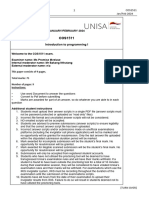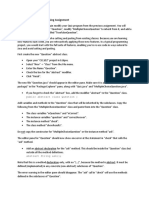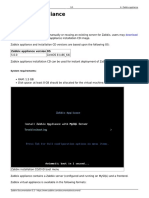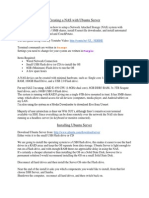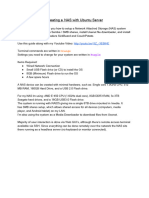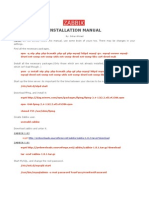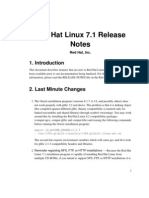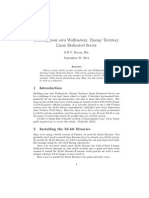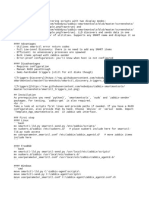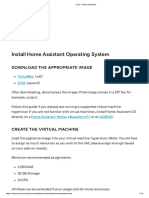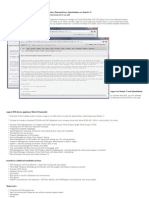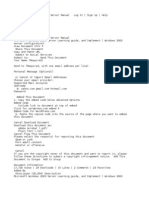Zabbix Appliance
Zabbix Appliance
Uploaded by
RobertHernandezCopyright:
Available Formats
Zabbix Appliance
Zabbix Appliance
Uploaded by
RobertHernandezOriginal Description:
Original Title
Copyright
Available Formats
Share this document
Did you find this document useful?
Is this content inappropriate?
Copyright:
Available Formats
Zabbix Appliance
Zabbix Appliance
Uploaded by
RobertHernandezCopyright:
Available Formats
2016/11/03 10:53
1/8
5. Zabbix appliance
5. Zabbix appliance
Overview
As an alternative to setting up manually or reusing an existing server for Zabbix, users may download
a Zabbix appliance or Zabbix appliance installation CD image. Zabbix appliance installation CD could
be used for instant deployment of Zabbix server (MySQL), Zabbix server (PostgreSQL), Zabbix proxy
(MySQL) and Zabbix proxy (SQLite 3).
Zabbix Appliance virtual machines have prepared Zabbix server with MySQL support. It is built using
Zabbix appliance installation CD.
Zabbix installation CD/DVD boot menu
Booting Zabbix appliance
Zabbix appliance and installation CD versions are based upon the following Ubuntu versions:
Zabbix appliance version Ubuntu version
3.0.0
14.04.3
Zabbix appliance is available in the following formats:
vmdk (VMware/Virtualbox)
OVF (Open Virtualisation Format)
KVM
HDD/flash image, USB stick
Live CD/DVD
Xen guest
Microsoft VHD (Azure)
Microsoft VHD (Hyper-V)
To get started, boot the appliance and point your browser at the IP it has received over DHCP:
http://<host_ip>/zabbix
It has Zabbix server configured and running on MySQL, as well as frontend available.
The appliance has been built using standard Ubuntu/Debian feature called Preseed files.
1 Changes to Ubuntu configuration
There are some changes applied to the base Ubuntu configuration.
1.1 Repositories
Zabbix Documentation 3.0 - https://www.zabbix.com/documentation/3.0/
Last update: 2016/08/09 12:46
manual:appliance https://www.zabbix.com/documentation/3.0/manual/appliance
Official Zabbix repository has been added to /etc/apt/sources.list:
## Zabbix repository
deb http://repo.zabbix.com/zabbix/3.0/ubuntu trusty main
deb-src http://repo.zabbix.com/zabbix/3.0/ubuntu trusty main
1.2 Firewall
The appliance uses iptables firewall with predefined rules:
Opened SSH port (22 TCP);
Opened Zabbix agent (10050 TCP) and Zabbix trapper (10051 TCP) ports;
Opened HTTP (80 TCP) and HTTPS (443 TCP) ports;
Opened SNMP trap port (162 UDP);
Opened outgoing connections to NTP port (53 UDP);
ICMP pakets limited to 5 packets per second;
All other incoming connections are dropped.
1.3 Additional packages
Various basic utilities have been added that could make working with Zabbix and monitoring in
general easier:
iptables-persistent
mc
htop
snmptrapfmt
snmp-mibs-downloader
Some of these packages are used by Zabbix, some of them are installed to help users to
configure/manage appliance settings.
1.4 Using a static IP address
By default the appliance uses DHCP to obtain the IP address. To specify a static IP address:
Log in as root user;
Open file /etc/network/interfaces in your favourite editor;
iface eth0 inet dhcp iface eth0 inet static
Add the following lines after iface eth0 inet static:
address <IP address of the appliance>
netmask <network mask>
gateway <your gateway address>
Run the commands sudo ifdown eth0 && sudo ifup eth0.
For more information about other possible options see the official Ubuntu documentation.
https://www.zabbix.com/documentation/3.0/
Printed on 2016/11/03 10:53
2016/11/03 10:53
3/8
5. Zabbix appliance
To configure DNS, add nameserver entries in /etc/resolv.conf, specifying each nameserver on its own
line: nameserver 192.168.1.2.
1.5 Changing time zone
By default the appliance uses UTC for the system clock. To change the time zone, copy the
appropriate file from /usr/share/zoneinfo to /etc/localtime, for example:
cp /usr/share/zoneinfo/Europe/Riga /etc/localtime
1.6 Locale changes
The appliance contains a few locale changes:
Contains languages: en_US.UTF-8, ru_RU.UTF-8, ja_JP.UTF-8, cs_CZ.UTF-8, ko_KR.UTF-8, it_IT.UTF-8,
pt_BR.UTF-8, sk_SK.UTF-8, uk_UA.UTF-8, fr_FR.UTF-8, pl.UTF-8, zh_CN.UTF-8;
Default locale is en_US.UTF-8.
These changes are required to support a multilingual Zabbix web-interface.
1.7 Other changes
Network is configured to use DHCP to obtain IP address;
Utility fping is set to have permissions 4710 and is owned by group zabbix - suid and only allowed
to be used by zabbix group;
ntpd configured to synchronise to the public pool servers: ntp.ubuntu.com;
LVM volume is used with ext4 filesystem.
UseDNS no is added to SSH server configuration file /etc/ssh/sshd_config to avoid long SSH
connection waits;
Daemon snmpd is disabled using /etc/default/snmpd configuration file.
2 Zabbix configuration
Appliance Zabbix setup has the following passwords and other configuration changes:
2.1 Credentials (login:password)
System:
appliance:zabbix
Use sudo su command with appliance user name password to get root access rights
Zabbix Documentation 3.0 - https://www.zabbix.com/documentation/3.0/
Last update: 2016/08/09 12:46
manual:appliance https://www.zabbix.com/documentation/3.0/manual/appliance
Database:
root:<random>
zabbix:<random>
Database passwords are randomly generated during the installation process.
Root password is stored to /root/.my.cnf file, it is not required to input a password under the root
account.
Zabbix frontend:
Admin:zabbix
To change the database user password it has to be changed in the following locations:
MySQL;
/etc/zabbix/zabbix_server.conf;
/etc/zabbix/web/zabbix.conf.php.
2.2 File locations
Configuration files are placed in /etc/zabbix.
Zabbix server, proxy and agent logfiles are placed in /var/log/zabbix.
Zabbix frontend is placed in /usr/share/zabbix.
Home directory for user zabbix is /var/lib/zabbix.
2.3 Changes to Zabbix configuration
Server name for Zabbix frontend is set to Zabbix Appliance;
Frontend timezone is set to Europe/Riga (this can be modified in /etc/apache2/confavailable/zabbix.conf);
2.4 Preserving configuration
If you are running a Live CD/DVD version of the appliance or for some other reason cannot have
persistent storage, you can create a backup of the whole database, including all configuration and
gathered data.
To create the backup, run:
sudo mysqldump zabbix | bzip2 -9 > dbdump.bz2
Now you can transfer the dbdump.bz2 file to another machine.
To restore from the backup, transfer it to the appliance and execute:
bzcat dbdump.bz2 | sudo mysql zabbix
https://www.zabbix.com/documentation/3.0/
Printed on 2016/11/03 10:53
2016/11/03 10:53
5/8
5. Zabbix appliance
Make sure that Zabbix server is stopped while performing the restore.
3 Frontend access
Access to frontend by default is allowed from everywhere.
The frontend can be accessed http://<host>/zabbix.
This can be customised in /etc/apache2/conf-available/zabbix.conf. You have to restart the
webserver after modifying this file. To do so, log in using SSH as root user and execute:
service apache2 restart
4 Firewall
By default, only the ports listed in changes are open. To open additional ports just modify
/etc/iptables/rules.v4 or /etc/iptables/rules.v6 files and reload firewall rules:
service iptables-persistent reload
5 Monitoring capabilities
Zabbix installation is provided with the support for the following:
SNMP
IPMI
Web monitoring
VMware monitoring
Jabber notifications
EZ Texting notifications
ODBC
SSH2
IPv6
SNMP Traps
Zabbix Java Gateway
6 SNMP traps
Zabbix appliance uses snmptrapfmt to handle SNMP traps. It is configured to receive all traps from
everywhere.
Authentication is not required. If you would like to enable authentication, you need to change the
/etc/snmp/snmptrapd.conf file and specify required auth settings.
All traps are stored in the /var/log/zabbix/snmptrapfmt.log file. It is rotated by logrotate before
reaching 2GB file size.
Zabbix Documentation 3.0 - https://www.zabbix.com/documentation/3.0/
Last update: 2016/08/09 12:46
manual:appliance https://www.zabbix.com/documentation/3.0/manual/appliance
7 Upgrading
The appliance Zabbix packages may be upgraded. To do so, run:
sudo apt-get --only-upgrade install zabbix*
8 Naming, init and other scripts
Appropriate init scripts are provided. To control Zabbix server, use any of these:
service zabbix-server status
Replace server with agent for Zabbix agent daemon or with proxy for Zabbix proxy daemon.
8.1 Increasing available diskspace
Create a backup of all data before attempting any of the steps.
Available diskspace on the appliance might not be sufficient. In that case it is possible to expand the
disk. To do so, first expand the block device in your virtualization environment, then follow these
steps.
Start fdisk to change the partition size. As root, execute:
fdisk /dev/sda
This will start fdisk on disk sda. Next, switch to sectors by issuing:
u
Don't disable DOS compatibility mode by entering c. Proceeding with it disabled will damage the
partition.
Then delete the existing partition and create a new one with the desired size. In the majority of cases
you will accept the available maximum, which will expand the filesystem to whatever size you made
available for the virtual disk. To do so, enter the following sequence in fdisk prompt:
d
n
p
1
(accept default 63)
(accept default max)
https://www.zabbix.com/documentation/3.0/
Printed on 2016/11/03 10:53
2016/11/03 10:53
7/8
5. Zabbix appliance
If you wish to leave some space for additional partitions (swap etc), you can enter another value for
last sector. When done, save the changes by issuing:
w
After partition creation (new disk or extended existing) create physical volume:
pvcreate /dev/sdb1
Partition name /dev/sdb1 is used in the example; in your case disk name and partition number could
be different. You can check partition number using fdisk -l /dev/sdb command.
Check newly created physical volume:
pvdisplay /dev/sdb1
Check available physical volumes. There must be 2 volumes zabbix-vg and newly created:
pvs
Extend your existing volume group with the newly created physical volume:
vgextend zabbix-vg /dev/sdb1
Check zabbix-vg volume group:
vgdisplay
Now extend your logical volume with the free PE space:
lvextend -l +100%FREE /dev/mapper/zabbix--vg-root
Resize your root volume (can be done on a live sysyem):
resize2fs /dev/mapper/zabbix--vg-root
Reboot the virtual machine (as the partition we modified is in use currently). That's it, filesystem
should be grown to the partition size now. Check /dev/mapper/zabbixvg-root volume:
df -h
9 Format-specific notes
9.1 Xen
Converting image for XenServer
Zabbix Documentation 3.0 - https://www.zabbix.com/documentation/3.0/
Last update: 2016/08/09 12:46
manual:appliance https://www.zabbix.com/documentation/3.0/manual/appliance
To use Xen images with Citrix Xenserver you have to convert the disk image. To do so:
Create a virtual disk, which is at least as large as the image
Find out the UUID for this disk
xe vdi-list params=all
If there are lots of disks, they can be filtered by the name parameter name-label, as assigned when
creating the virtual disk
Import the image
xe vdi-import filename="image.raw" uuid="<UUID>"
Instructions from Brian Radford blog.
9.2 VMware
The images in vmdk format are usable directly in VMware Player, Server and Workstation products.
For use in ESX, ESXi and vSphere they must be converted using VMware converter.
9.3 HDD/flash image (raw)
dd if=./zabbix_appliance_3.0.0_x86_64.raw of=/dev/sdc bs=4k conv=fdatasync
Replace /dev/sdc with your Flash/HDD disk device.
10 Known issues
From:
https://www.zabbix.com/documentation/3.0/ - Zabbix Documentation 3.0
Permanent link:
https://www.zabbix.com/documentation/3.0/manual/appliance
Last update: 2016/08/09 12:46
https://www.zabbix.com/documentation/3.0/
Printed on 2016/11/03 10:53
You might also like
- SM3 ComboDocument1 pageSM3 ComborxNo ratings yet
- Cos1511 Jan-Feb 2024 ExamDocument11 pagesCos1511 Jan-Feb 2024 ExammvunelkNo ratings yet
- Introduction To ZabbixDocument17 pagesIntroduction To ZabbixAlizaShaikhNo ratings yet
- CS 1102 Unit 5 Programming AssignmentDocument3 pagesCS 1102 Unit 5 Programming AssignmentKareem Nabil17% (6)
- SAS SANs For DummiesDocument52 pagesSAS SANs For DummiesRBDx3No ratings yet
- Zabbix ApplianceDocument10 pagesZabbix ApplianceVictor Fredy López YauriNo ratings yet
- Zabbix ApplianceDocument9 pagesZabbix ApplianceHelton Carlos Lima GodoyNo ratings yet
- Configuracion de ZabbixDocument8 pagesConfiguracion de ZabbixOscar CerdasNo ratings yet
- Zabbix ApplianceDocument8 pagesZabbix ApplianceVahidNo ratings yet
- Zabbix Appliance (Zabbix Documentation 5.0)Document4 pagesZabbix Appliance (Zabbix Documentation 5.0)Fabio CabralNo ratings yet
- Zabbix ApplianceDocument5 pagesZabbix ApplianceAndres SBNo ratings yet
- Zabbix Appliance: RAM: 1.5 GB Disk Space: at Least 8 GB Should Be Allocated For The Virtual MachineDocument5 pagesZabbix Appliance: RAM: 1.5 GB Disk Space: at Least 8 GB Should Be Allocated For The Virtual Machinekwang kpopperNo ratings yet
- Zabbix Appliance: RAM: 1.5 GB Disk Space: at Least 8 GB Should Be Allocated For The Virtual MachineDocument5 pagesZabbix Appliance: RAM: 1.5 GB Disk Space: at Least 8 GB Should Be Allocated For The Virtual MachinemoukeNo ratings yet
- Creating A NAS With Ubuntu ServerDocument10 pagesCreating A NAS With Ubuntu ServerkaleonardoNo ratings yet
- Zabbix 3 Installation From SourcesDocument11 pagesZabbix 3 Installation From Sourceskool vascoNo ratings yet
- ManualDocument12 pagesManualhmoeenNo ratings yet
- Fedora ServerDocument38 pagesFedora ServerTestoje TestovićNo ratings yet
- Creation NASDocument15 pagesCreation NASDaryn Freeze NyangonoNo ratings yet
- Zabbix Install ManualDocument6 pagesZabbix Install ManualGohar AhmedNo ratings yet
- Linux Adm 2Document16 pagesLinux Adm 2Mark ZuñaNo ratings yet
- LinuxmanualDocument12 pagesLinuxmanualJose Navas TapiaNo ratings yet
- Rhel5 Pamphlet I731Document2 pagesRhel5 Pamphlet I731YashveennNo ratings yet
- Securing UbuntuDocument29 pagesSecuring UbuntusushikeNo ratings yet
- Install OMV On Iomega HMNHD Cloud Edition With Disk Image - v05Document4 pagesInstall OMV On Iomega HMNHD Cloud Edition With Disk Image - v05KApps KAppsNo ratings yet
- How To Install Mysql Server 5.6 On Debian 7 and 8Document10 pagesHow To Install Mysql Server 5.6 On Debian 7 and 8RiDwan Atarashi EdogawhaNo ratings yet
- Installing Groundwork Monitor 6.6 - Support - GWConnectDocument5 pagesInstalling Groundwork Monitor 6.6 - Support - GWConnectkenyrNo ratings yet
- Red Hat Linux 7.1 Release NotesDocument13 pagesRed Hat Linux 7.1 Release Notespaul_dinaNo ratings yet
- VirtualBox Oracle Linux VMDocument5 pagesVirtualBox Oracle Linux VMzahazhNo ratings yet
- Secure Machine Translate)Document24 pagesSecure Machine Translate)nvphucvnNo ratings yet
- User Manual of The Pre-Built Ubuntu 12.04 Virutal MachineDocument5 pagesUser Manual of The Pre-Built Ubuntu 12.04 Virutal MachineDrum CodeNo ratings yet
- Building Your Own Wolfenstein: Enemy Territory Linux Dedicated ServerDocument6 pagesBuilding Your Own Wolfenstein: Enemy Territory Linux Dedicated ServerguidokrNo ratings yet
- Install Arch Linux in VirtualBox VM GitHubDocument6 pagesInstall Arch Linux in VirtualBox VM GitHubFrancescoMoscatoNo ratings yet
- Linux Manual Assignment 1Document18 pagesLinux Manual Assignment 1Usama JavedNo ratings yet
- Ubuntu Server GuideDocument377 pagesUbuntu Server GuidesupercoachNo ratings yet
- 1 Install The Base System: Boot From Your Fedora Core 5 DVD or CD (CD 1)Document20 pages1 Install The Base System: Boot From Your Fedora Core 5 DVD or CD (CD 1)antonyabirawaNo ratings yet
- Snort 2.8.4.1 Ubuntu PDFDocument13 pagesSnort 2.8.4.1 Ubuntu PDFCharlistNo ratings yet
- (Howto) Install Optware On Atheros Units (Such As WNDR3700)Document3 pages(Howto) Install Optware On Atheros Units (Such As WNDR3700)nbspNo ratings yet
- Install Zabbix Monitoring Tool On CentOS, RHEL, Scientific Linux 6Document15 pagesInstall Zabbix Monitoring Tool On CentOS, RHEL, Scientific Linux 6AymenNo ratings yet
- Installation Guide - ArchWikiDocument6 pagesInstallation Guide - ArchWikiFreeEveryNo ratings yet
- Squid HowtoDocument7 pagesSquid Howtormanola100% (1)
- Using Conquest On LINUX - Version 1.5.0 Mar 14, 2020: InstallationDocument11 pagesUsing Conquest On LINUX - Version 1.5.0 Mar 14, 2020: Installationrebr88No ratings yet
- 3d ConnexionDocument3 pages3d ConnexionSerkan OzkaymakNo ratings yet
- New Document TexteDocument8 pagesNew Document Texteayoub.iservNo ratings yet
- Redhat ClusterDocument16 pagesRedhat ClusterOrlando Rubino100% (1)
- Template SNMP IBM Director AgentDocument3 pagesTemplate SNMP IBM Director AgentDamian BustamanteNo ratings yet
- Cygwin Linux SFTP Server Installtion On Windows 2008 R2Document6 pagesCygwin Linux SFTP Server Installtion On Windows 2008 R2Udayantha WithanaNo ratings yet
- Arch Linux VM in VirtualBoxDocument7 pagesArch Linux VM in VirtualBoxrashed44No ratings yet
- Diskless Remote Boot in LinuxDocument14 pagesDiskless Remote Boot in Linuxkarthickk02No ratings yet
- Virtual Domain ConfigurationDocument36 pagesVirtual Domain ConfigurationsatishnuniNo ratings yet
- Linux Interview NotesDocument57 pagesLinux Interview NotesclicknirajNo ratings yet
- Beginners' Guide - ArchWikiDocument26 pagesBeginners' Guide - ArchWikiPramandha ArthadanaNo ratings yet
- Linux - Home Assistant - Install Home Assistant CoreDocument12 pagesLinux - Home Assistant - Install Home Assistant Corefaszomjoska23No ratings yet
- Installation OpenMeetings 3.0.x On Ubuntu 14.04 PDFDocument17 pagesInstallation OpenMeetings 3.0.x On Ubuntu 14.04 PDFFendy ChandraNo ratings yet
- Install Manjaro Like A Pro Using CLIDocument12 pagesInstall Manjaro Like A Pro Using CLIJuan Carlos Galue AraujoNo ratings yet
- Configuring FreeNAS PDFDocument23 pagesConfiguring FreeNAS PDFvinothkumar_senthoorpandian100% (1)
- Mini Howto Part 1: Setup A Napp-It: Zfs-Server Appliance On Illumian, Nexentacore, Openindiana or Solaris 11Document17 pagesMini Howto Part 1: Setup A Napp-It: Zfs-Server Appliance On Illumian, Nexentacore, Openindiana or Solaris 11Ziggy SmithNo ratings yet
- Snort Ids Tutorial PDFDocument18 pagesSnort Ids Tutorial PDFAlberto Acevedo AliagaNo ratings yet
- Installation Guide - ArchWikiDocument8 pagesInstallation Guide - ArchWikiSeth RelianNo ratings yet
- Ubuntu Server Guide PDFDocument371 pagesUbuntu Server Guide PDFJuan Karlozz Piña GutièrrezNo ratings yet
- Configuration of a Simple Samba File Server, Quota and Schedule BackupFrom EverandConfiguration of a Simple Samba File Server, Quota and Schedule BackupNo ratings yet
- Configuration of a Simple Samba File Server, Quota and Schedule BackupFrom EverandConfiguration of a Simple Samba File Server, Quota and Schedule BackupNo ratings yet
- Evaluation of Some Windows and Linux Intrusion Detection ToolsFrom EverandEvaluation of Some Windows and Linux Intrusion Detection ToolsNo ratings yet
- Q2 Computer 10 New Week 5Document5 pagesQ2 Computer 10 New Week 5Andrhey BagonbonNo ratings yet
- Ac500 PDFDocument188 pagesAc500 PDFMubarak DAPLNo ratings yet
- LogDocument31 pagesLogNabilla ChintyaNo ratings yet
- Dell Inspiron N5110 (Wistron Queen 15) SSID VIDEODocument1 pageDell Inspiron N5110 (Wistron Queen 15) SSID VIDEOrodrigoNo ratings yet
- Cisco AP Password ResetDocument17 pagesCisco AP Password ResetVL RickettsNo ratings yet
- Dipal Ashok Thokale ResumeDocument1 pageDipal Ashok Thokale Resumedipalthokale2000No ratings yet
- ArbitrumDocument18 pagesArbitrumAbhay MalikNo ratings yet
- FPGA DesignDocument2 pagesFPGA Designahmadniazi911No ratings yet
- Script SharpDocument62 pagesScript Sharpwebpro_xNo ratings yet
- Gujarat Technological UniversityDocument2 pagesGujarat Technological UniversityluckiiNo ratings yet
- cs411-quiz-3-by-vu-topper-rmDocument17 pagescs411-quiz-3-by-vu-topper-rmAhmad BaigNo ratings yet
- Android BrochureDocument2 pagesAndroid BrochureHarsh SinghNo ratings yet
- Gepard Crash LogDocument3 pagesGepard Crash LogBahha NeryNo ratings yet
- Parts of A ComputerDocument15 pagesParts of A ComputerAnnie Rose MahinayNo ratings yet
- MindShare SAS Ebook v1.1Document631 pagesMindShare SAS Ebook v1.1Karthik DmgNo ratings yet
- MIS - 104: Computing Fundamentals: BBA Department of MIS University of DhakaDocument22 pagesMIS - 104: Computing Fundamentals: BBA Department of MIS University of DhakaMahbubNo ratings yet
- Eee g512 324 Course HandoutDocument2 pagesEee g512 324 Course HandoutAnupjyoti DekaNo ratings yet
- Push Pull Meter - Act - 1000n PDFDocument7 pagesPush Pull Meter - Act - 1000n PDFSuraj RawatNo ratings yet
- Intel Builders: Partner DirectoryDocument144 pagesIntel Builders: Partner Directorysafyh2005No ratings yet
- Matt Graham IT ResumeDocument2 pagesMatt Graham IT Resumetest1233674No ratings yet
- DS Interview CodingDocument22 pagesDS Interview CodingManaswinee CNo ratings yet
- The Google Web Toolkit:: Using GWT RPC To Access Server-Side DataDocument33 pagesThe Google Web Toolkit:: Using GWT RPC To Access Server-Side DataDeepak Kumar SinghNo ratings yet
- Fujitsu H730 Specs SheetDocument6 pagesFujitsu H730 Specs SheetAleksandar VasicNo ratings yet
- Bill-Wiedeman ToolDocument7 pagesBill-Wiedeman ToolIonel BorbelNo ratings yet
- Samsung GT-E2550 Gte2550 - User - ManualDocument66 pagesSamsung GT-E2550 Gte2550 - User - ManualraveNo ratings yet
- A Microsoft Windows 2003 Server ManualDocument45 pagesA Microsoft Windows 2003 Server Manualanon-783527100% (3)

